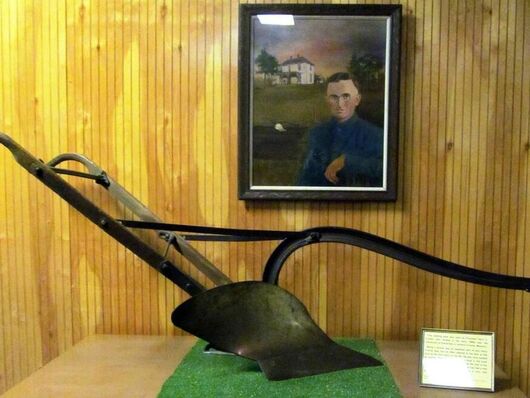Agricultural Exhibits
|
The Museum of Farming is more than 20,000 square feet of floor space devoted to antique farm machinery and implements.
|
The Gallery showcases unique and rare artifacts including the plow President Harry S. Truman used as a boy along with a prairie schooner, 150-year-old Native American plow, 1903 Dart truck, horse-drawn mail wagon, large collection of Depression glass and more!
|
The Art Gallery houses a large collection of rural art. The Harvest Queen mural was donated to the Ag Center in 1965. It was painted by Kansas artist George Melville Stone for the Kansas Agriculture Exhibit at the 1915 Panama-Pacific Exposition in San Francisco.
|
|
“Hard Times: Life in America During the 1930s” is on view in the main museum’s newly renovated gallery. Black-and-white photos portray life in America during the Great Depression and Dust Bowl eras. The photos were selected from the Farm Security Administration photography division’s collection of more than 200,000 images taken from 1935 to 1944.
|
The Agricultural Hall of Fame honors individuals who have made outstanding contributions to agriculture. The 200-seat National Rural Electric Cooperative Theater has state-of-the-art audio/visual equipment and houses the National Association of Farm Broadcasters Hall of Fame. Learn more about the Hall of Fame and its inductees.
|
Farm Town USA is a collection of buildings depicting pioneer life. The one-room Island Creek School House was built in 1917 in Piper, Kansas, and used as a school until 1961. Youngsters can experience a day at school complete with state-accredited curriculum. Farm Town also contains a Hatchery, Blacksmith Shop and General Store. The miniature narrow-gauge Union Pacific train takes visitors for a ride around the lake. The Smith House was donated by sisters Etta Blanche Smith-Dahlgreen and Kathryn Charlotte Smith-Wilcox. The building itself is a replica built for the Ag Center while the furnishings, appliances and decorations inside are original to the Smith family’s 1890s home. It stands as a tribute to their pioneer parents and grandparents who came to Kansas from Wisconsin shortly after the Civil War. Vegetable, flower and pollinator gardens, tended by the Master Gardeners, add beauty and valuable resources throughout the campus.
|
The National Farmer’s Memorial was designed by American sculptor Lewis Watkins and dedicated in 1986. “To the farmers of America because of the sacrifices that you have made, because of the hardships that you have endured, because of your determination to succeed.”
|
The Walk of Fame provides a tangible way to show your appreciation of the American farmer and recognize a loved one at the same time. Purchase a brick engraved with a loved one’s name. Learn more here.
|












